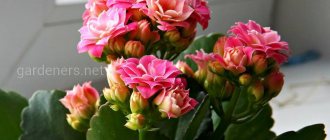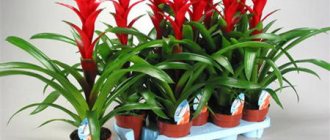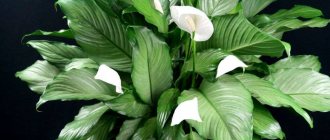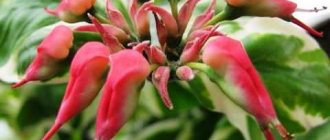The color of the flowers can be white or yellow, it all depends on the variety, but the plant blooms at home extremely rarely.
Pachira fruits are oval-shaped and olive-colored, with a maximum size of 10-25 centimeters. The fruit itself is not edible, but its seeds, covered with a peel, can be eaten. The pachira seeds (nuts) are removed from the fruit and then processed to taste: they can be eaten raw, boiled or roasted.
The flowers and leaves of the plant are also edible, but are rarely eaten.
Description, varieties and photos
Below is a description of the most popular indoor varieties and their photos:
Pachira aquatica (Aquatica), which is also called the bottle tree. The leaves of the plant have an oblong shape with five branches and are dark green in color. The stem has an internal depression, which, by accumulating moisture, helps Aquatica survive in extreme heat without special care.
Pachira silver, which differs from the previous variety only in the silver pattern on the leaves.
Pachira rotundifolia, which is very different from its relatives. Its leaves are round in shape, and its stems creep along the soil rather than growing upward.
Types of houseplant Pachira
Pachira Water (Aquatica)
Pachira aquatica (Aquatica) is the most popular type of Pachira in home cultivation. This miniature tree has a characteristic thickening of the lower part of the trunk, the size of which directly depends on the growing conditions. Thanks to this thickening filled with nutritious moisture, Pakhira normally tolerates lack of watering and dry soil in the pot, but excessive watering is contraindicated for it. The dark green leaves of the tree are interesting - complex finger-shaped with a wrinkled surface, shiny and leathery. The flowering period is long, from June to November. Under favorable indoor conditions, flowering can last all year round. Moreover, during flowering, the tree does not shed its leaves, as some of its relatives do.
This may be interesting: Cordyline - types and varieties for indoor growing
On a long, up to 35 cm, panicle there are large flowers with many stamens. The colors of the flowers are different - white, pink or pale green. The aroma of flowers is reminiscent of vanilla. The fruits of Pachira are large, up to 25 cm, light green berries, elliptical in shape, which quickly become woody. After ripening, the fruit splits in the center. Inside it are seeds ranging from 10 to 25 pieces. The seeds are covered with a tough brown shell, which is why they are sometimes called nuts. These nuts can be eaten raw, boiled or roasted. You can use them to grind flour and bake bread. In addition, a drink that tastes like chocolate is prepared from the nuts.
Pachyra rotundifolia . This species is distinguished by long creeping shoots with rounded leaves. In indoor conditions it is grown as an ampelous plant.
Pachira silver
Pachira silvery . The plant is similar to Pachira aquaticus, the difference is in the leaves - they have silvery stripes.
Reproduction
Pachira can be propagated in only two ways:
- using seeds - a natural method of reproduction,
- using the cutting method, which can be used as the plant grows.
When using the second method, it is important to know that the cuttings must have a “heel” in order for Pakhira to take root. The cuttings should be transplanted into a pot with a small diameter, and the subsequent transplantation should be done a year later, preferably in the spring.
Planting a plant
When growing a flower from seeds, you should take into account the shelf life and proper storage. This information must be read on the packaging. Sowing is done on top of moist soil , after which the seeds need to be sprinkled with a thin layer of soil and sprayed with water.
To achieve early germination of the plant (in about 3-4 weeks), you can cover the pot with film, however, if the room temperature is high enough, this should not be done. The subsequent replanting of the plant will take place only after a year.
Sowing this exotic flower must be done in the spring - this way Pakhira will feel more comfortable, and subsequent replanting will be successful.
How to transplant correctly?
For subsequent replanting of young plants, you should choose a low, shallow pot with a good drainage layer at the bottom.
It is better to buy soil at a flower shop intended for dracaenas. Transplantation is carried out annually at the end of March. When preparing the soil yourself, you need to combine turf, leaf soil and sand. You can also add some brick chips or charcoal - this will help strengthen the trunk. When replanting pachira, the diameter of the pot should be increased by 5 centimeters.
Young plants need to be replanted every year, and adults every 3 years.
In the room where it is planned to grow pachira, a number of conditions must be met. We will tell you which ones further.
Growing pachira from seeds
Pachira from seeds photo shoots
Pachira is propagated by seed and cuttings.
Seeds quickly lose their viability, so sow them fresh. Take a container with a peat-sand mixture, moisten the soil, spread the seeds over the surface and sprinkle with a little soil. Cover the crops with glass or transparent film. Maintain the air temperature at 25-30° C. Ventilate the crops daily and periodically spray the soil. Expect germination in 20 days. Strong young plants are transplanted without picking into separate pots with soil for adult specimens.
Plant care
Watering and humidity
This plant does not need too frequent watering; it is accustomed to a hot, dry climate. It should be watered as the soil dries, and the bottom watering technique should be used. The trunk should not be allowed to get wet, otherwise this may lead to its rotting and the pachira will die. The water should be at room temperature or slightly warm. In autumn and winter, pachira should be watered less frequently than usual.
The humidity requirements of this plant are also minimal; it can only be lightly sprayed in the morning and evening hours, as is the case with watering, without touching the plant trunk. Spraying should be done only in spring and summer; the plant does not need it in winter and autumn.
If the pachira leaves begin to fall off, the reason for this may be too frequent watering. In this case, it is better to leave the plant alone, and subsequent watering can be done through the tray in which the pot stands. In this case, it is necessary to make small holes in the pot so that the roots of the plant can absorb moisture.
Necessary feeding and fertilizers
From spring to the end of summer, the plant needs regular feeding , which can be purchased at a flower shop.
Fertilizing is not difficult, you just need to add the concentrate in the required amount to the pot with the plant, you can lightly loosen the soil so that it better absorbs the necessary substances.
The complex includes several mineral fertilizers at once, and no fertilizing is required in autumn and winter.
Temperature Requirements
In spring and summer, the temperature regime should be as close as possible to the conditions in which the plant is accustomed to being. The minimum value on the thermometer scale will be 25 degrees. In autumn and winter, the temperature can be reduced to 16 degrees.
During the hot period, it is necessary to ensure ventilation of the room where the pakhira is located, but drafts should not be allowed.
Lighting requirements
The absence of direct sunlight and drafts - these are the basic principles for choosing a place for pachira . This flower loves bright, diffused light, so it is better to place it on the east or west side. A window facing north will not work; the plant will not have enough light, which is the source of its nutrition.
The south side is suitable only if the plant is provided with shade during the period of active sunlight. You can place the pot both on the balcony and on your summer cottage in the summer, but you should gradually accustom the pachira to its new environment. It is also important to protect the flower from precipitation.
Trimming
With the arrival of spring, it is necessary to trim the stems , which begin to stretch.
The plant may thus lose its stability. From the point of cutting, new foliage begins to grow, and therefore the crown of the pachira becomes more luxuriant, and the plant acquires an aesthetic appearance.
Experienced gardeners trim stems using various techniques. Pachira often becomes the object of such an art form as bonsai.
Shaping the trunk
Pachira is a solitary flower, but there are cases when several seedlings are planted in a pot at the same time to decorate a room. As the trunks grow, they can be braided to their liking ; braided braiding is very popular. In a few years (on average 3-4 years) you will be able to admire an interesting creation.
Pachira is one of several plants that the Japanese use in the everyday interior of their homes. It fits perfectly into the minimalist and loft style.
Useful video
An interesting video about caring for pachira at home: pruning, watering, why does it shed its leaves?
How to create a trunk-pigtail
Young stems of Pachira have excellent flexibility. This allows you to create conditions for its future decorative appearance at an early stage of plant growth. If you plant two or three Pachira cuttings of equal height in one pot at once, you can create your own original specimen of the plant with an intertwined stem. To do this, well-rooted cuttings are curled in a spiral or braided, and the top is carefully tied with twine so as not to disturb the movement of sap in the stems. While the seedlings do not hold their shape well, they can be temporarily tied with improvised means - rope or twine. When the trunks become older and gain moisture well, they will begin to independently maintain the shape they are given - then the holding ropes can be removed. The plant continues to grow. You remove excess leaves and continue curling the trunks. This procedure must be carried out until the stems begin to become lignified. In areas where the stems touch, the bark can be cut off, then the stems will grow together, and Pachira will look more harmonious and decorative. We warn you that the process of creating your masterpiece will take quite a long time - at least a couple of years.
To make the crown lush and beautiful, pruning of the apical shoots of Pachira is done at home in the spring. The plant will quickly grow green mass and delight you with young bright green leaves.
Diseases and pests
In comparison with other indoor plants, pachira is considered not picky, however, like everyone else, it is susceptible to attack by various diseases and pests.
The most common pests are:
- spider mite,
- aphid,
- thyroid gland,
- thrips.
In case of damage, parts of the flower should be removed and treated with special chemicals sold in a flower shop. The type of product depends on the type of insect that caused the damage. If the stem is damaged, it also needs to be treated by planting the flower from the pot and replanting it in fresh soil, because pests can remain in its inner layers even after treatment.
Problems in cultivation, pachira pests
Pachira's trunk has softened due to overflow
Due to errors in care, the appearance of the plant becomes painful.
- Check the hardness and elasticity of the barrel. A softened trunk indicates the beginning of rotting of the root system, caused by waterlogging of the earthen clod. The plant must be dug up, the affected areas must be trimmed, and the cut areas must be treated with charcoal wood chips. After this, plant the pachira in new soil and do not water it for a week.
- The edges or tips of the leaves turn brown due to insufficient watering, dry air or drafts.
- The leaves become soft, curl, and their tips turn brown due to temperature changes. Check to see if the air temperature during the day is suitable, but at night it drops below normal.
- Due to lack of lighting, the stem stretches and loses its thickening.
- When exposed to direct sunlight, sunburn may occur - dry spots will appear on the leaves. Shade the plant immediately.
- Falling leaves can be caused by an excessively voluminous container (the pot is too large and deep).
- Yellowing of the foliage occurs due to a lack of minerals in the soil - they must be added in liquid form.
Rules of care
The basic rules for caring for a flower are as follows:
- excessive watering of the pachira is unacceptable, otherwise the roots and trunk may rot, mold will form and the plant will die,
- the presence of drafts is also unacceptable, because we must not forget that the flower comes from South America, which means it loves warm climates,
- changes in room temperature, as well as direct sunlight, negatively affect the well-being of the plant, it may turn yellow,
- You cannot place a flower near artificial heating sources - a battery, a heater, otherwise this threatens the death of the plant, because the soil becomes dry with such content and the air humidity decreases, the pachira lacks oxygen.
What to do if the leaves turn yellow and fall off?
Cases when the leaves of a flower turn yellow and fall off are common and indicate that the plant was provided with improper care and maintenance.
In this situation, you should pay attention to feeding, because... insufficient soil nutrition affects the health of the flower.
A common cause of yellowing of the plant is direct sunlight on the leaves . Try moving the pachira to another place or creating a small shadow.
If the flower has black and curled leaves, this may be a sign of frostbite, so the flower should be placed in a more suitable place with a temperature of at least 25 degrees. Feeding the flower should be done 2-3 times a month, and then observe the growth of the plant and its appearance.
If none of the above measures produce results, you can try replanting the flower in fresh soil and providing proper care.
How to deal with pests - table
| Pests | Damage | Control measures |
| Spider mites | Small purple insects. As a result of their attack, the leaves turn yellow and become covered with cobwebs. |
|
| Shields | When a scale insect attaches itself to a leaf, a yellow spot appears there, gradually increasing in size. The leaf turns yellow, curls and falls off. | The insect is covered with a “shield”, so spraying has almost no results. You need to collect pests manually: moisten a napkin in a solution of Aktara or Karbofos and carefully wipe all the leaves. |
| Aphid | Small insects (look like white droplets). They feed on the juice of leaves. Leave sticky marks. |
|
| Thrips | Small insects with a narrow, elongated body and wings. They leave traces - small dark dots. They destroy leaves and are carriers of viruses and diseases. |
|
Pachira leaves fall off and turn yellow. What should I do?
- If you have not replanted the plant after purchasing it, soon the leaves of the pachira will begin to turn yellow and fall off due to the lack of nutrients in the soil and acidification of the soil. An urgent transplant with soil replacement is needed. In order for the plant to quickly take root, it can be watered with a root solution.
- Dropping of the lower old leaves is normal, especially when the plant enters its dormant period in the fall.
- Very dry air can also cause leaves to turn yellow and dry out; you need to place a humidifier nearby or keep the plant on a tray with damp expanded clay.
- Drying out the roots also causes leaves to fall off. The solution is to establish the correct watering regime. All yellowed leaves should be cut off to give the plant a chance to recover; it is advisable to fertilize it to maintain the flower in a stressful situation.
- During the cold period, the money tree may suffer from drafts: if the window is open, do not also open the door. Draft and hypothermia can also cause leaves to fall.
- Add epin to the water for spraying pachira to help the plant recover from yellowing leaves, remembering to identify and eliminate the cause.
Signs and superstitions
Feng Shui philosophy associates pachira with a certain talisman that brings good luck, prosperity and health to the house. This flower weakens the effects of negative energies . One of the signs that is associated with the formation of the next pachira leaf is an increase in wealth in the house.
According to popular belief, it is not customary to give away pachira, otherwise it may have a bad effect on other plants in the house. If, after all, the owner decided to give this exotic flower, then it is necessary to take something in return.
Introduction
The homeland of this unusually beautiful plant is the tropical part of Central and South America . Pachira is called a bottle tree , and it belongs to the baobab family .
Evergreen smooth leaves grow on long petioles, and flowering begins in June and ends in November, but if conditions change, the onset of this phase may shift. Large flowers have a vanilla scent and are collected in an inflorescence - a panicle.
You can visually familiarize yourself with the Pachira Aquatica the photo below.
Photo gallery
ninawergal_
torik_i_sherik
cvetivokrug
gloxiniastar
katya_zukovskaya
my_flowers_rnd
Pachira transplant
Blue pigweed: basics of home care and examples of popular varieties
Typically, the palm-like pachira requires replanting every three years. In this case, you need to choose a pot that is about 5 cm larger than the previous one. If the tree is young, then replanting is carried out once a year. As a filling, choose a soil mixture suitable for dracaenas and palm trees. This soil is distinguished by the fact that it is not overloaded with nutrients and has a slightly increased acidity.
If you wish, you can make the soil for the pachira yourself. To do this, you need to take turf soil and sand in equal proportions, then mix thoroughly. Since the flower has a superficial root system, when planting there is no need to deepen the roots too deeply into the ground. This will prevent the root system from rotting in the future.
To ensure that the crown of a home tree does not lose its decorative appearance, the pachira should be pruned from time to time. As a rule, this is a spring procedure. Before you start trimming overgrown branches, you need to make sure that the branches are strong enough and can withstand pruning without damage.
Pachira transplant
Difficulties in growing
When breeding pachira, flower growers may encounter some difficulties, which are most often associated with illiterate care and non-compliance with established standards for watering, fertilizing or lighting. As a result of such actions, the plant may be susceptible to various ailments or affected by pests.
Pests
One of the advantages of home pachira is that it is rarely attacked by pests, only in rare cases can it be affected by spider mites or scale insects:
- the presence of sticky liquid on the foliage and yellowing of the greenery are evidence of the harmful effects of the scale insect;
- the presence of transparent cobwebs on the trunk and between the leaves indicates the presence of spider mites.
To rid the plant of unwanted guests, the foliage and trunk should be treated with insecticidal preparations.
Diseases
You can easily learn about crop diseases by simply looking and studying its appearance:
- A soft and limp trunk is evidence of excessive soil moisture. To revive the crop, it must be transplanted into another container, completely replacing the soil, removing rotten roots and treating the root system with charcoal powder.
- The leaves of the pachira turn yellow and fall off - this situation indicates that the pot was chosen incorrectly (its size is too large). In such cases, it is recommended to transplant the pachira into a less spacious container.
- The leaves become soft, curl, and darken at the tips - this is a consequence of sudden temperature changes and exposure to drafts. Correcting the temperature regime will help save the plant.
- The leaves become lighter and brown spots form on them - the cause is considered to be excess light, as well as possible sunburn. The flower pot should be moved to another place or provided with shading.
Possible errors in care and treatment - table
| Problem | Probable Cause | Solution |
| The trunk softens and black spots appear on it. | Excessive watering at low room temperatures. Pakhira does not like dampness. |
|
| The tips of the leaves dry out. Subsequently, they lose turgor and wither. |
|
|
| The leaf blades curl into a tube, and a brown border appears along the edge of the leaf. | Pachira is too cold. The plant freezes already at +15 degrees. | Adjust the temperature. |
| The stem becomes thin, the plant practically does not grow, the trunk loses its characteristic bottle shape. | Lack of light. | Place the pot closer to the window or illuminate the pachira with a fluorescent lamp. |
| Light-colored spots appear on the leaf blades, after which these areas dry out. | Sunburn. | Shade the pakhira from too intense lighting with tulle or a sheet of paper. |
| The leaves are turning yellow. |
|
|
Interesting Facts
In 1968 on the island. In Taiwan, a simple driver came up with the idea of growing several small trees in one pot, braiding their trunks into a bizarre spiral. After some time, the fashion for the braided tree spread throughout Asia. In the East, pachira is endowed with mystical properties that attract financial success. In Japan, this plant, tied with colored ribbons, is usually placed in enterprises. The Chinese believe that each cinquefoil blade represents one of the elements: fire, air, water, earth and wood. Therefore, it is customary to keep this tree at home to bring harmony and peace.
Note! On the American continent, pachira fruits are eaten with pleasure. They are used to bake bread, roast them like chestnuts, boil them, and prepare drinks reminiscent of hot chocolate. Some people prefer a salad made from the leaves and flowers of this extraordinary plant.
More conservative Europeans enthusiastically shape this representative of the Baobabs into wonderful bonsai, competing in weaving intricate trunks.
Thus, this is a universal flower that not only pleases the eye with its unusual appearance, but also brings benefits according to world beliefs. It is not difficult to grow it, the main thing is to adhere to the basic rules described above.











